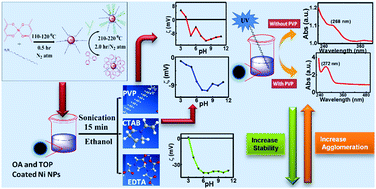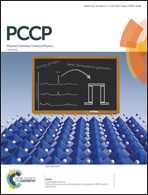Influence of particle size and dielectric environment on the dispersion behaviour and surface plasmon in nickel nanoparticles†
Abstract
Nickel nanoparticles (NPs) are promising candidates for various applications, including biomedical ones, as they have good magnetic properties as well as high thermal conductivity. We used well-characterized Ni NPs of average Scherrer sizes from 1.31 nm to 22.23 nm and investigated the effects of the primary particle size, size distribution and dielectric environments, and of separately adding non-ionic polyvinylpyrrolidone (PVP), cationic cetyltrimethylammonium bromide (CTAB) and anionic ethylenediaminetetraacetic acid (EDTA) in ethanol, on their stability and agglomeration behaviour using atomic force microscopy (AFM), particle size analysis and zeta potential study through dynamic light scattering (DLS) combined with UV-visible spectroscopy data. The dominant influence of surfactants, additives, particles size and shape on the surface plasmon resonance (SPR) was found. SPR is considerably sensitive to the dielectric environment in addition to size and shape. Moreover, increasing the concentration of PVP led to an enhanced SPR intensity and a shift in its position towards higher wavelength. 1.31 nm NPs with EDTA as an additive yielded the best dispersibility and also showed superparamagnetic behaviour at 300 K, indicating their favourable application potentials.



 Please wait while we load your content...
Please wait while we load your content...